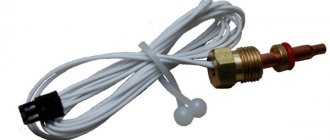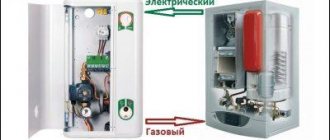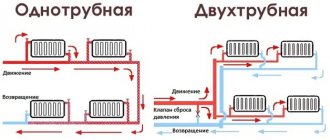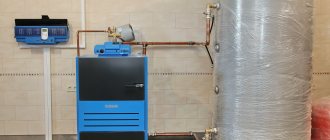A room thermostat today is simply an indispensable complementary module for a heating boiler. For an uninformed person, this is simply an expensive remote temperature controller that allows you to control the climate in the house directly from the living room.
In practice, a good and functional thermostat costing 3-5 thousand rubles, with proper operation, can greatly reduce operating costs for heating, maintain a more stable temperature, reduce the frequency of turning on and off a gas boiler, which will extend its life.
Models of room thermostats are universal and are suitable for all boilers (gas, solid fuel, liquid fuel, electric) that have the appropriate connectors for connecting it (see the instructions for the boiler).
What is a thermostat for a heating boiler?
This is what a modern electronic room thermostat looks like.
Why is it needed and how is it used
The main reason for choosing a room thermostat is savings, that is, a reduction in fuel consumption by up to 25-30%. This is achieved through the ability to program the boiler’s operation for a day or a week in advance. For example:
- You can reduce the temperature at night to 18-19°C - the most comfortable temperature for sleeping. Moreover, each reduced degree reduces fuel consumption by 2-5%.
- You can lower the temperature to 15-16°C for times when the owners are not at home, for example during working hours.
Also, savings are achieved even without a programming function: by controlling the operation of the boiler depending on the air temperature, and not the coolant temperature. This allows you to more accurately and stably, without the slightest jumps, maintain the set temperature, minimize the inertia of the heating system, and if you have a modulating burner, keep it on for as long as possible, but at minimum power - the most optimal mode of operation of the boiler both in terms of fuel consumption and conservation of the resource.
Everything, even the simplest mechanical room thermostats, come with an air temperature sensor by default. Many models also include a remote sensor for heated floors.
Of course, in addition to saving money, the thermostat also increases the operating comfort of the heating system. Depending on the functionality, using the thermostat you can organize weather-dependent control by connecting an external street sensor, control the boiler from a smartphone (via Wi-Fi) and receive notifications of operational failures via SMS (if there is a GSM module), simply fine-tune the operation boiler
Existing types
The settings specified on the thermostat always have priority for the boiler; its operating principle does not change (modulation of the burner flame is used, adjustment of the turbine rotation speed, etc.) despite the “dry contact” with the thermostat. The operating principle of a room thermostat depends on the type of temperature sensor it uses.
1. Mechanical thermostats
The simplest and most inexpensive models without any broad functionality. The principle of their operation is to use membrane sensors - heat-sensitive metals, liquids or gases, which are placed in a small sealed capsule. When heated, the substances expand and, upon reaching the set temperature, exert pressure on the relay membrane sufficient to close the contacts, after which the thermostat sends a signal to reduce the boiler power or turn it off completely.
Mechanical devices, as a rule, are limited only by a rotator for selecting temperature, have a noticeable error of up to 3-4°C, and only have a wired connection method.
2. Electromechanical
More accurate (but still not enough), more expensive, still limited in functionality thermostats.
The principle of operation is similar to the action of mechanical ones, but in this case, heat-sensitive metals are used, which, when heated, produce a micro-discharge or create resistance. Some models have a simple screen for displaying temperature and a smaller step for changing it - 0.5°C. However, this still poorly justifies their 30-40% higher price, given that there are more accurate and functional analogues.
3. Electronic
Modern, accurate, multifunctional and convenient thermostats. The kit often includes additional sensors for heated floors. The error of electronic models is no more than 0.5-0.7°C, most have the ability to be programmed, almost all devices are equipped with functions of protection against overheating and freezing, stopping the circulation pump and other safety systems.
The most expensive models have built-in Wi-Fi and GSM modules, save statistics, have a large number of automatic modes and a wireless connection to the boiler. Despite the highest cost, electronic room thermostats fully justify it and pay for themselves within a few months of proper use.
When does the thermostat not save gas?
There are quite a few reviews like this on the Internet: “I fell for the sellers’ assurances about saving 30%, bought and installed a temperature regulator, now the boiler consumes more gas. Why is it needed at all? Let's figure out how this device saves energy (not only gas, but also solid fuel, diesel fuel and electricity):
- The interval between starts of the heat generator increases. The reason is that the cooling and heating of the air occurs more slowly than the water in the batteries.
- Together with the burner, the circulation pump is turned off, consuming up to 100 W of electricity. In TT boilers the fan (turbocharger or smoke exhauster) stops.
- The premises are fully heated at the right time when residents are at home. During other hours, a reasonable permissible temperature is maintained. It is recommended to reduce the heating at night - for a comfortable sleep, it is enough to heat the rooms at 18-19 °C.
Explanation. Reasonably acceptable means the temperature at which the boiler will quickly warm up the rooms to a comfortable level without much energy consumption. It is determined empirically and lies within 15-18 degrees.
Now let’s look at situations where, instead of saving, there is increased consumption or deterioration in heating:
- The boiler is set to the minimum coolant temperature (40-45 °C), because the underfloor heating circuits are connected directly. The heater operates with low efficiency, gas consumption does not decrease.
- When the home is heated exclusively with warm floors, and the thermostat does not measure in the lower zone of the room. The screed and air warm up slowly, and at the moment the sensor is triggered, the floors become too hot. When cooling, the opposite picture is observed.
- The heat loss of the building is too great. No thermostats will help here; insulation is required.
- The temperature sensor-boiler connection is incorrectly configured, the hysteresis (temperature difference between starting and stopping the heat generator) is incorrectly selected.
Each thermostat provides a temperature difference between turning off and turning on the boiler. The value can be changed within 0.5-2 degrees. If maximum hysteresis is selected and the house is heated with underfloor heating, the air temperature difference will increase greatly, staying in the room will become uncomfortable, and the heat generator will consume more fuel for heating.
The master installer will tell you about the intricacies of setting the thermostat in the video:
We achieve maximum stability and comfort
An additional feature of many electronic thermostats is the ability to organize weather-dependent control, when the boiler power is adjusted, including changes in the outside temperature. To do this, just connect a universal outdoor temperature sensor to the thermostat (2-2.5 thousand rubles).
External temperature sensor for Gira thermostat 130200.
It consists of a single structure: a sensor and a wire 2-6 m long. Therefore, it is enough just to fix the wire strands in the corresponding contacts of the thermostat, according to the instructions.
How to choose a room thermostat for a heating boiler
Wired or Wireless
Wired models are not limited in functionality, can be installed in any room (up to 20 meters from the boiler), are cheaper, but require a wired connection to the boiler. The wire itself is usually provided in the kit.
Wireless thermostats consist of a control panel with an air temperature sensor (essentially a regular thermostat) and a receiver that receives a signal from the remote control and transmits it to the boiler in a wired manner. Accordingly, the receiver is installed in the boiler room, and there may be more than one thermostat, for example, in several rooms. The advantages of wireless communication are obvious: there is no need to run wires throughout the house.
From the thermostat to the receiver, the signal is transmitted over a standard household appliance channel with a frequency of 433 or 868 MHz and does not affect any other household appliances or any other electronic devices in the house. Most models transmit signals over distances of up to 20 or 30 meters, taking into account walls, ceilings or partitions. It is worth considering that batteries are required to power a wireless thermostat, usually 2 standard AA batteries.
Temperature setting accuracy
Mechanical and electromechanical thermostats are quite cheap, but have a high error in the context of home heating - from 2 to 4°C. In this case, the temperature adjustment step is usually 1°C.
It is better to choose a more accurate electronic model with an error of 0.5-0.7°C and an adjustment step of 0.5°C. This is unlikely to have an impact on savings, but definitely on comfort. In addition, the main function for which the thermostat is so valued, the programmer, is available only in electronic models.
Ability to set the hysteresis value
Hysteresis (lag, delay) in the context of a heating system and thermostat is the difference between the temperature at which the boiler turns on and off with a uniform flow of coolant. That is, if the temperature on the thermostat is set to 22°C, and the hysteresis is 1°C, then when the air temperature reaches 22°C, the boiler will turn off and start when the temperature drops by 1°C, that is, at 21°C.
In mechanical models, the hysteresis is usually 1 or 2°C and cannot be changed. In electronic models with the ability to adjust it, you can set the value to 0.5°C or even 0.1°C. Accordingly, the lower the hysteresis, the more stable the temperature in the house.
Availability of a programmer
An example of a programmable thermostat with a temperature graph displayed on the main screen.
The programmer is an opportunity to set a boiler operation pattern for a time period from 8 hours to 7 days. Of course, manually lowering the temperature before leaving for work, leaving or going to bed is quite troublesome. Using the programmer, you can create one or several operating templates once and, depending on the temperature and hysteresis settings, save up to 30% of fuel each subsequent month.
This means that even when heating a small house with an area of 80-100 m2, a high-tech, expensive thermostat for 4-6 thousand rubles will pay for itself in 2-4 months of the heating season.
Availability of Wi-Fi or GSM module
Controllers with a Wi-Fi module can be connected to the home network and controlled using an application on a smartphone. A rather tangible advantage is the GSM module, with the help of which you can not only turn on the heating system in advance and heat the house even before arrival, but also control the operation of the system during a long departure: in case of any malfunctions, a corresponding notification will be sent to your phone.
Security systems
Protection against overheating or freezing of the heating system, protection against stopping the circulation pump, protection of the pump against souring in the summer (on once a day for 15 seconds) - all these functions seriously increase the safety of the heating system and are often found in medium and high-priced boilers segments. If such systems are not provided by the boiler automation, the issue can be resolved by choosing a thermostat with them.
The best known manufacturers and models: characteristics and prices
BAXI KHG
A well-known simple mechanical thermostat without additional functions or settings. Among mechanical analogues, it is distinguished by Italian build quality and reliability, standard hysteresis of 1°C, and minimalistic, pleasant design. The disadvantages are standard for all mechanical devices - high error, temperature steps of 1°C rather than 0.5°C, constant hysteresis.
TEPLOCOM TS-Prog-2AA/8A
Wired programmable electronic thermostat. It is distinguished by the presence of almost all the functions available today at a low price, essentially the best choice in terms of price-quality ratio.
It has a good contrast display, the ability to set minimum and maximum temperatures, pump protection mode, protection against overheating and freezing, indication of system malfunction, setting hysteresis, programming temperature schedules for 7 days, etc.
The disadvantages are the wired connection and, despite this, power from 2 AA batteries, they are enough for 1-1.5 years of operation.
TEPLOCOM TS-Prog-2AA/3A-RF
The programmable thermostat is absolutely similar to the previous model, but with a wireless connection at a frequency of 868 MHz, which means an increase in the reception range up to 100 meters. The receiver is connected to the boiler via a wired connection. The disadvantage of this model is its rather high price, since wired analogs for this price can have built-in Wi-Fi and GSM modules, and the kit includes sensors for heated floors.
TEPLOLUX MCS-350
One of the best room thermostats for a heating boiler. It has almost all modern monitoring and protective functions, 24/7 programming mode, and detailed consumption statistics. It is distinguished by the presence of a touch LCD display with automatic locking, the presence of a Wi-Fi module that allows you to control the system from a smartphone, and an additional remote temperature sensor included (up to 32 sensors can be connected in total).
Thanks to Wi-Fi, the thermostat can be installed in any inconspicuous place and controlled from a smartphone, but even with an open installation, it will harmoniously fit into almost any interior.
Selection rules
When choosing a temperature sensor for a heating boiler, the following installation parameters are taken into account:
- How, where and in what way the regulator will be installed.
- Maximum permissible dimensions.
- Operating range of control and regulation of temperature indicators.
- Sensitivity limit.
- Intended purpose for installation - outdoor, indoor, overhead or submersible.
- Basic and additional functionality.
- Control options – via panel, remote control, remotely.
Prices: summary table
| Manufacturer and model | Peculiarities | Cost, rub. | Our rating, 0-5 points |
| BAXI KHG | Mechanical, inexpensive and reliable | 1 350 | 3,9 |
| TEPLOCOM TS-Prog-2AA/8A | Programmable, wired, functional, best in price-quality ratio | 3 600 | 4,5 |
| TEPLOCOM TS-Prog-2AA/3A-RF | Programmable, wireless, functional, expensive | 5 500 | 4,3 |
| TEPLOLUX MCS-350 | Programmable, wired, functional, with Wi-Fi module and touch display, with additional. sensor, modern stylish design | 5 200 | 4,9 |
Connecting the thermostat to the boiler: instructions
To obtain accurate measurement results, it is important to choose the right installation location:
- Installation near windows, entrance doors, ventilation ducts, climate control equipment and other objects that can affect the air temperature at the installation site is not recommended;
- It is not recommended to install it too high, near the ceiling, or too low to the floor, since heated air masses are concentrated near the ceiling, and in the absence of a heated floor, the temperature in the lower plane of the room is noticeably lower. The optimal installation height is 1.5 meters from the floor level;
- Installation near moving objects or objects that create mechanical shocks (doors, furniture touching the wall) is not recommended;
Also note that for loads above 10 A, the device is not connected directly, but through a modular contactor.
The connection and installation algorithm is always specified in the instructions for the device. For example, let's look at how to install a mechanical Cewal RQ-10:
| Photo | Process description |
| Remove the temperature control rotator | |
| Having removed the front panel, unscrew the corresponding screws | |
| We mount the structure on the wall through the appropriate holes specified in the instructions. | |
| According to the diagram from the instructions, connect the contacts. For the Cewal RQ-10 model, this diagram is shown in the photo. | |
| Additionally. There may be a jumper between the “TA” contacts of the board of some boilers; it must be replaced with a two-core insulated cable with a conductor cross-section of 0.5-0.75 mm2. |
Most modern thermostats are powered by AA batteries, but if power from the mains is required, its organization diagram looks like this:
All modern models of thermostats are supplied with instructions with a detailed, schematic description of the installation, connection and configuration algorithm. However, this requires basic electrical skills in any case.
Thermostatic control valves
The thermostatic valve is a simple solution to the problem of obtaining a coolant at a given temperature by mixing colder water with warmer water. The three-way valve is shown below:
Three-way valve
Scheme for connecting a three-way valve to the heating system:
Scheme for connecting a three-way valve to a heating system
Piping diagram for a solid fuel boiler using a thermostatic three-way valve:
Piping diagram for a solid fuel boiler using a thermostatic three-way valve
Piping diagram for a gas boiler using a thermostatic three-way valve:
Piping diagram for a gas boiler using a thermostatic three-way valve
The thermostatic radiator valve allows you to control the temperature in the room by varying the flow of hot water through the radiator. They regulate the flow of hot water through the radiator, but do not control the boiler. Such devices must be installed to adjust the temperature needed in each individual room.
This idea should be considered as an addition to the thermal control installation. Also, such devices require periodic readjustment and regular performance checks (every six months when changing operating modes).











